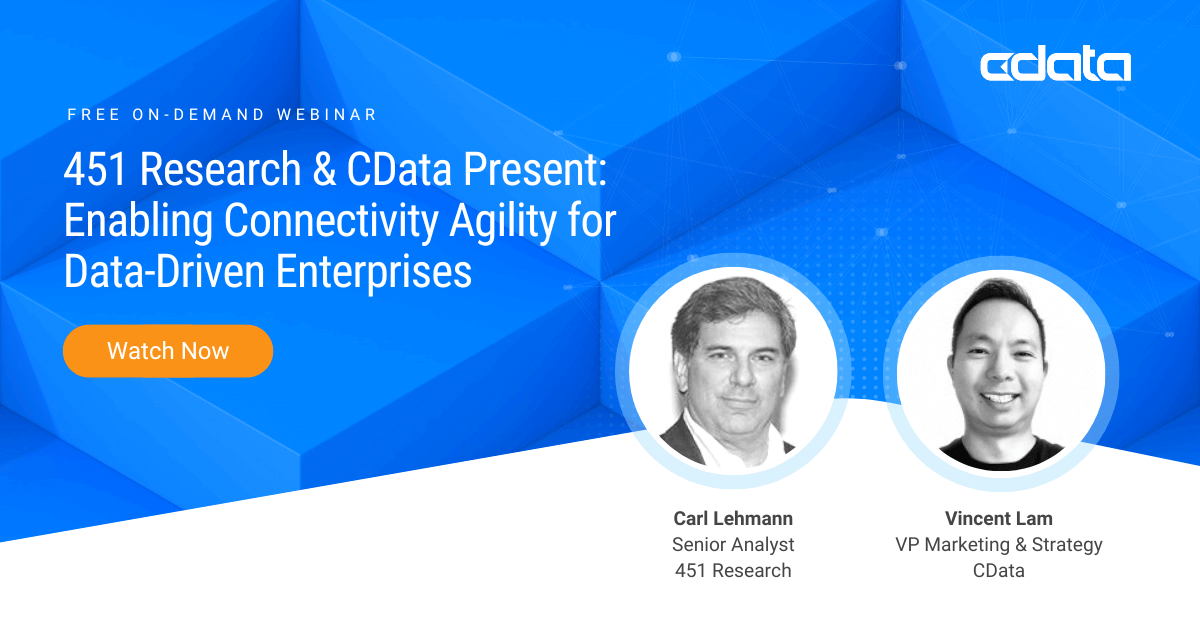Enable Connectivity Agility for Data-Driven Enterprises

As organizations push to drive business decisions with data, new opportunities are obscured by unprecedented IT challenges. To help more organizations chart a more agile path toward data-driven decisions, we invited 451 Research to unpack these challenges in a recent webinar.
CData Technology Evangelist Jerod Johnson was joined by 451 Research Senior Research Analyst Carl Lehmann and CData VP of Marketing and Strategy Vincent Lam for this session. This article recaps some of the highlights from the event to give you a glimpse into how a next-generation solution, Data Connectivity as a Service, is enabling better decisions with data.
Watch the webinar on-demand
What’s Fueling the Need to be Data-Driven?
In a recent survey, 451 Research reports that only 21% of businesses are driving nearly all their strategic decisions using data. Most businesses have a lot of room to improve and plenty of incentive to gain a competitive advantage.
“Data-driven decisions are better than hunches. You can’t manage what you can’t measure, and measurement is a key part of running a business. The only way to do that is to capture that data needed to run the business.”
– Carl Lehmann, 451 Research Senior Research Analyst
Better data-driven decisions can improve business processes, decisions, services, and productivity. But several roadblocks keep these organizations from supporting decisions with data.
What are the Barriers to Becoming Data-Driven?
The typical state of enterprise data is often too fragmented and complex to solve alone. From a high level, many organizations are experiencing a lack of data access and the means to overcome it.
1. Lack of data integration and expertise
Making data accessible across siloed applications and systems is about more than just building custom integration solutions. Line of business users need to be able to see, understand, and analyze their data without IT intervention. “IT is not the answer,” said Lam. “IT cannot chase down every single new and existing silo to serve the needs of this entire community of data users in an effective way.”
2. Data continues to be highly distributed
Today’s hybrid IT architecture contains many legacy on-premises and newer cloud platforms — each with its own self-contained data. Most organizations report having anywhere from 11 to upwards of 500 silos, including document stores, applications, and other systems. “With very different APIs, or some data being structured versus unstructured, how we access each silo is incredibly different and inconsistent,” said Lam.
4. Self-service is too manual
“Manual operations are prone to errors, inaccuracy, and consistency,” said Lehmann. Yet, today’s self-service data analysis relies on sifting through spreadsheets and documents, limited prebuilt dashboards, or relying on others to prepare and send data. Self-service needs automation.”
5. Employees expects more automation
IT automation isn’t just needed, it’s expected. “Some respondents believe 20% of all IT processes will be or should be automated within the next year,” said Lehmann. “That’s a phenomenal increase. Enterprises will have to operate very differently — with tools they either do not have or are unaware of.”
How Does Data Connectivity as a Service Help?
Most enterprises leverage some form of Integration Platform-as-a-Service (iPaaS) today to integrate data and processes. However, these platforms often offer many capabilities that create complexities. “Today’s iPaaS requires many sets of technical skills that are usually in scarce supply,” said Lehmann.
An evolution of iPaaS — known as Data Connectivity as a Service — automates and simplifies a wide range of integration capabilities, enabling enterprises to realize the benefits of being data-driven. “Data Connectivity as a Service enables connectivity as a self-service — meaning abstracting away the complexity of these tools,” Lehmann.
“You should be able to connect to anything you want,” said Lam. “You could be a techie developer, but you can also be a business user that writes reports using your favorite tool like Power BI. Data Connectivity as a Service should support any user, any tool, and any store.”
“Data Connectivity as a Service simply expands your connectivity options within your data ecosystem. There are absolutely reasons to still move data with ETL, but this presents other options to support additional scenarios where you don’t have to move the data to use it – you can just connect to it directly.”
– Vincent Lam, CData VP of Marketing & Strategy
1. Benefits for IT organizations
Once the data access platform is set up, users don’t have to request IT for connections to access and use data from distributed sources. With IT resources unburdened, technical staff becomes free to refocus on higher-value initiatives.
2. Benefits for developers and users
“Sometimes data scientists spend too much time getting to the data they need,” said Lehmann. Not only will data teams accelerate their analysis and reporting processes, but day-to-day knowledge workers speed up their own time-to-value with automated self-service.
3. Benefits for the enterprise
With platforms concentrated on automation and self-service, organizations are now better equipped to overcome data challenges. Organizations can now automate key tasks to easily connect the workforce with data they need to drive decisions, actions, and ultimately a better bottom line.
How Does CData Enable the Data-Driven Enterprise?
CData recently introduced Data Connectivity as a Service to our suite of connectivity solutions with CData Connect Cloud. “We do all the hard work to figure out how to best connect to your systems. Then, we abstract it with our own layer — containing a SQL engine that presents the whole world as SQL,” said Lam.
CData Cloud Connect works out-of-the-box to enable latency-free, bi-directional data access across all of your on-premises and cloud systems.
“You simply start in a web browser, browse through the hundreds of eligible sources, configure in your favorite tool of choice, and start using it,” said Lam. “And while IT can be involved to help manage it, individual users can get started now without any IT assistance.”
Explore CData Connect Cloud and get started today with a free trial.





